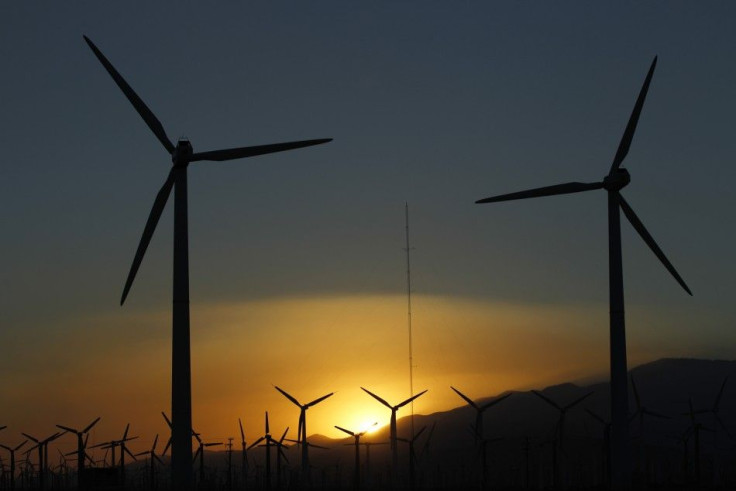Tax Credit Expiration Threatens Growth of U.S. Wind Energy Industry

The American Renewable Energy Production Tax Credit is set to expire by the end of next year in 2012, but if it doesn't get extended sooner rather than later, domestic wind turbine manufactures and suppliers will be feeling an ever-increasing pinch.
The 2.2 cent per kilowatt hour tax credit has been responsible for promoting more than $60 billion of wind energy investment in the last six years, and the creation of 400 manufacturing and wind industry supply facilities throughout the country, according to data compiled by the American Wind Energy Association.
By keeping electricity rates low, the tax break is credited for helping to reduce the cost of wind power by more than 90 percent and increasing the overall value of a turbine manufactured in the United States, based on information from the AWEA website.
But that is poised to change. Faced with a looming deadline, manufacturers of turbine components from steel to bolts to contracting companies stand to lose business.
Ellen Carey, a spokesperson with the wind energy association, said wind turbine manufacturing plants typically give orders for wind turbine components years in advance, but faced with the tax credit's 2012 deadline, uncertainty is flying high and orders are not being made.
Carey said wind turbine component suppliers have received no new orders after 2012, and the Energy Information Administration projects a 100 percent drop in industry growth in 2013 if the tax credit expires, according to the wind association's website.
Wind Energy Suppliers Wary
Jan Smutny-Jones, the executive director of the Independent Energy Producers Association, based in Sacramento, Calif., told the International Business Times there is at least several billion dollars worth of wind investments taking place in California, and that the tax credit has helped bring the price of wind energy down.
The production tax credits are a good way of stimulating development, Smutny-Jones said, but if the production tax credit is allowed to expire, he suspects wind energy development in California to grind to a halt - from 2,000 added megawatts to zero.
Matt Riley, cheif executive officer for Infinity Wind Power based in Santa Barbara, Ca., which has 3,248 megawatts worth of projects throughout the country, said his order books are full until Jan. 1, 2013. He said because no one knows if the tax credit will be allowed to expire, his company has no firm projects for that year.
I'm quite worried, but you have to have the stomach for the long term, Riley said, who added his company will likely maintain its portfolio and not scale any of its projects down. What we are more concerned about is uncertainty.
Riley suspects 2013 will be a very tough period for the industry in general, even if the tax credit is extended at some point next year. Faced with uncertainty the year before and a drop in the number of future orders, companies will not have the time to put together wind projects, which sometimes run in the hundreds of million of dollars, before 2013, Riley said.
If [congress] acted now, I think 2013 won't be that bad, Riley said.
Industry Growth Stalls
As of Dec. 7, the bill, which was first introduced on Nov. 2, is in the House Committee on Ways and Means. It must clear the committee before the bill can be debated in both the House and the Senate. As it is proposed, the bill will extend the tax credit until 2016.
Riley said he is worried the wind industry's growth and increased momentum will come to an abrupt end if the extension fails.
In the four-year period between 2004 and 2008, the wind industry in the U.S. saw a 292 percent increase in the number of net wind energy produced nation-wide, from 14,100 to 55,300 megawatts, according to the American Wind Energy Association.
In Texas, where the most wind energy capacity is installed, wind energy development continues, but at a more muted pace.
Things are slower that they have been in the past, said Russel Smith, the executive director of the Texas Renewable Energy Industries Association.
Smith said wind energy companies in Texas are of course concerned by the potential expiration of the tax credit, and that it has contributed to an overall decline in the industry, but growth is stymied more by how Texas wind power capacity has saturated the state's transmission capability.
Dottie Roark, a spokesperson for the Electric Reliability Council of Texas, which manages 85 percent of the state's electricity, said wind energy within Ercot will grow by 1,755 megawatts to 11,347 megawatts by 2014, based on projections dated as of Nov. 30, 2011.
Mark Higgins, the acting program manager for the Wind and Water Power Program with the U.S. Department of Energy, said the next frontier for wind energy lies in off-shore generation.
Higgins said wind farms in offshore fields can be larger than their land-locked counterparts and can generate more power as a result, and the Department of Energy is offering roughly $40 million in grants for offshore wind power.
The grants are being offered at a time when the renewable industry in the U.S. could face an even further setback.
The Treasury Department's 1603 Program, which reimburses applicants for a portion of the cost of installing a renewable energy project, is scheduled to expire by the end of December. If it is allowed to expire, financing for renewable energy projects from biomass to wind and solar will drop by 52 percent in 2012, according to a letter signed by 764 associations trade groups and companies, mailed to congress on Nov. 30.
For now, the industry is hoping level heads in congress will prevail and extend the tax credits, but deadlines are fast approaching.
It will be foolish policy to allow [the production tax credit] to expire, Riley said.
© Copyright IBTimes 2024. All rights reserved.




















